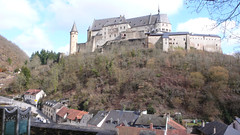Vianden, Luxembourg, March 8, 2012
UP PAST THE WALL and to the Château today. The Romans built a fort up there late during their Empire, and throughout the Dark Ages its ruins stood as a reminder I suppose of the good old days. by the time the early Middle Ages rolled around civic pride and perhaps an enhanced local economy led to improvements, and by the 15th century the place had become quite palatial, near what you see above.
Then hard times set in again. Vianden had been the capital of its fiefdom, but times changed. By the middle of the 19th century — odd:how recently I would have written that "the last century" — the two main gates in the town walls had been pulled down and the château itself had lost its roofs and interior carpentry. How, I don't yet know: fire, I should think. In any case, it was again a ruin, this time not Roman but Romantic.
In the 1980s, though, miraculously, the enthusiasm, technique, and above all money was found to restore the place. The result seems quite persuasive to me. There were of course plenty of descriptions and sketches and engravings to go on, and, I suppose, analogous buildings elsewhere (though not many of this caliber, I would bet). We spent an hour or so wandering the galleries, the huge rooms, the kitchen, the residence — I took thirty photos or so: masonry, carpentry, fascinating photodocumentation, scale models of the building at three different epochs. And we were entirely alone.
Lindsey read in a travel website that Vianden is to be avoided on summer weekends, when the town is overrun with Dutch, Belgian, and German tourists. I can believe it. But in these early days after Ash Wednesday most of the hotels are closed and the town is given back to its 3,000 or so residents. Curiously, many of these seem to be Portuguese. Our hotelkeep is, for example; my other blog will soon report on a bacalhau.
Four men were roofing one last part of the Château when we were up there, in beautifully fish-scaled overlapping curves, cutting each rectangular tile with a mason's hammer against an anvil spiked anew into the wood substrate as each course advanced. I thought the material must surely be synthetic ti be so even, but when I asked the crew flunky what it was, C'est ardoise, monsieur. I knew that was slate, but then asked sythethique? Ah non, monsieur, c'est naturelle.
Is it from here, then, I pressed. Ah non, monsieur, il vient d'espagne. I looked at him a little more closely: Como Usted, creo. Ah si, Señor, he responded, smiling.
Spanish slate, Spanish skill. Portuguese inn (Auber would be pleased). European community at work. Not so different, I'm sure, from what obtained during Roman times.
We had walked up to the château following an itinerary outside the town walls, laid up four feet thick and quite high of local flags of shale, I think — I'm no geologist. Towers are placed every thirty feet or so, an easy arrow-shot apart, close enough that no sentry-walk was needed for further protection. The towers are curious: often four or five stories high, they're open toward the town side: no infiltrators would have hidden in them! It's a shame the main gates were pulled down a century and more ago, but a greater wonder the walls themselves are nearly intact. They anchor the medieval taste the entire town seems to maintain, with its lack of permanent signage, sidewalks, asphalt, visible wires…
And yet I write this in a café-bar-club devoted to cinema; Sinatra and Billie Holiday and Jo Stafford provide the background music; my Martini is to my specifications, and very good…
Photos from today at http://benelux2012.shutterfly.com/pictures#n_5

No comments:
Post a Comment